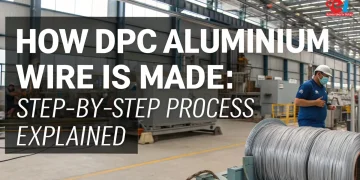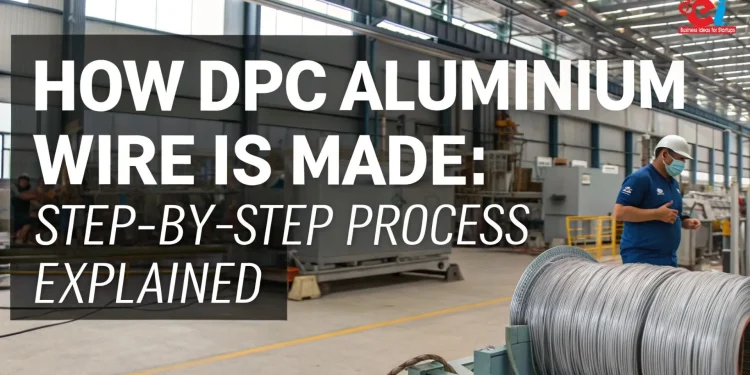As with several other industries, the Electrical and Power sector makes use of Double Paper Covered (DPC) aluminium wire in transformer windings and other coil-based electric machinery. The wire’s remarkable features such as high conductivity with thermal expansion, ability to withstand a plethora of temperatures, and affordability make oil-immersed transformers as well as reactors depend on DPC aluminium wire for its proper functionality.
Manufacturing a wire like this, however, comes with a great deal of challenges that need to be tackled through a series of precision steps aimed at guaranteeing the integrity, endurance, and performance of the final product. This article takes a deep dive into every single step involved in DPC aluminium wire production, from acquiring raw materials to preparing the product to be sold in markets.
Selecting DPC Aluminium Wire Raw Materials
We begin with selecting electrical grade aluminium rods or EC grade rods colloquially. These rods boast a purity rating of 99.5%, or higher which is ideal for electrical grade rods due to ensuring superb conductivity. The provided rods are typically in the form of coils and are subsequently checked for qualitative defects such as scratches, chemical, and physical inconsistencies.
Eradicating impurities is critical especially during the downstream processes of annealing and insulation, so this step is crucial in making sure the alloy composition will work seamlessly with the wire. The rods also have to pass a set value inspection prior to being stored under controlled conditions aimed at combating oxidation or contamination in order to keep the rod’s integrity intact before entering the drawing section.
Prior to the drawing stage, cleaning in the form of either mechanical or chemical ‘de-greasing’ systems are employed on the rods to remove grease, oxide layers or any foreign matter. In more sophisticated systems, ultrasonic cleaners and alkaline degreasers are used to prepare the aluminium surface to a level where no contaminants are present. This pre-cleaning guarantees that the wire to be drawn from these rods, maintains its integrity which will enable the rods to pass through various stages of manufacturing processes and suffering no damage ensuring proper insulation later on.
Related: The Aluminium Industry in India: A Growing Export Powerhouse
Drawing and Annealing
The process of wire drawing can be defined as a simple mechanical one where an aluminium rod is pulled through a set of dies which serve to lower its diameter to quite an extent. The dies are almost always produced from tungsten carbide or diamond since these materials can bear and stand the great friction and stress developed during the operation. This process serves not only to reduce the rod’s diameter and increase its length, but gives additional hardness to the aluminium. The side effect of hard aluminum is ill-fitting for winding applications, hence, the wire will mandatorily undergo annealing.
In the process of annealing, a wire is heated in a controlled atmosphere between the temperatures of 300°C to 450°C. This can be done using either a batch furnace or a continuous annealing line. Restoring the ductility and softening the wire so that it can be wound without breaking or creating cracks is what is done during the annealing process. From a modern manufacturing perspective, continuous annealing lines are favored due to their efficiency and consistency.
To minimize oxidation of the aluminium surface during the process, inert gases such as nitrogen are often used to purge the heating chamber. The wire is then cooled in a regulated environment, after which it is reeled into spools for the next production stage.
Surface Preparation
The process of drawing and annealing aluminium wires is likely to leave behind surface oxides and residue. This residue must be cleaned thoroughly as it may otherwise impede the bonding of the aluminium conductor and the insulating layers. Cleaning involves wire brushing, air jet cleaning or even acid pickling in extreme cases. It is quite important that the wire be dried, as moisture can impact the insulation process. Apart from improving the appearance of the wire, surface preparation also helps deliver the required performance and durability expected of a modern wire.
Paper Covering Process
This is the salient step of the DPC aluminium wire manufacture. The next step is to apply the insulating coating consisting of two layers of specially constructed electrical paper to the cleaned and annealed wire. The most commonly used insulation papers include kraft paper, crepe paper, and thermally upgraded paper. Kraft and crepe paper serve different purposes; the former offers mechanical strength while the latter provides flexibility required for tight coil winding in transformer core.
The wire is fed into a high-speed machine for papercutting, which wraps the first layer of paper in a helical manner around the wire in one direction. Then, a second layer is added in the reverse direction. This wrapping in opposite directions promotes better mechanical interlocking and helps in avoiding gaps which could lead to an electrical discharge.
Each step of the wrapping process can be controlled to maintain predetermined levels of coverage and thickness due to the tensioned feeding systems and guide rollers used during each step of the process. The overlap between the turns of the paper has been calculated to strike the right balance between reliable insulation and excessive bulk. In advanced manufacturing lines, the computer-controlled systems automate the control of paper tension, wrapping speed, and overlap to achieve homogenous insulation along the entire length of the wire.
Curing and Drying
It is important to remove any moisture from the insulation after the wire is wrapped in paper. Any moisture present can compromise dielectric strength and increase the chances of electrical failure in high-voltage applications. The drying of the wire is done through either hot-air ovens or controlled atmosphere drying tunnels. Both methods require a temperature range of 90°C to 120°C, and the time depends on the wire gauge and paper used. For more effective drying, some facilities use vacuum ovens or infrared heaters that heat uniformly.
After drying, the wire must be gradually cooled in a dehumidified space to prevent condensation. This step is important to prevent the paper insulation from being damaged due to moisture in the environment. The cooled wires undergo inspection for paper shrinkage, surface damage, and discoloration prior to being sent for quality control tests.
Related: Aluminium Wire Rod: The Best Industry for Your Investment
Aluminium Wire Quality Control and Inspection
Insulating conductor DPC Aluminium Wire performs only if the quality standards are met. Each batch of wire goes through numerous tests, checking mechanical and electrical properties. Conductor’s diameter, insulation thickness, and concentricity are obtained by applying micrometers and laser gauges. Electrical tests include insulation resistance testing using a megohmmeter and dielectric breakdown testing under high voltage to check if the paper layers withstand specified voltage thresholds.
Assessing finished item’s tensile strength, elongation, and flexibility provides information on mechanical testing. The bond strength of paper to the aluminium is checked to confirm the insulation does not come off during the coiling process and in service conditions. All quality testing procedures align with national and international standards like IS 13730, IEC 60317, and ASTM B233. Any wire coil not meeting the requirements gets either reprocessed or scrapped in order to maintain product dependability and customer confidence.
Spooling and Other Steps
The process of spooling can only commence after the DPC aluminium wire has undergone all the necessary quality assurance inspections. The wire is spooled either on wooden or steel drums which have been customized to suit the customer’s requirements and their specified wire length, while also ensuring the proper tension is applied during spooling to prevent damage to the insulation. In addition to this, the wire is masked using protective materials including polyethylene film or moisture-resistant wrap, to shield the insulation from external elements, during storage and transit.
During this stage, as in the previous stage, charging plays a critical role. A.B.S (P)’s internally developed paper, the tape constitutes each spool being labeled with a wire gauge, insulation thickness, paper type, batch number, production date, net weight, and credentials of the manufacturer. These aids in reinforcing product traceability and are supplemented by a certificate of conformity specifying vital test results pertaining to the batch. After this point, the spools are either palletized or boxed based on whether it is intended for export or domestic dispatch.
End-Use Applications and Market Dynamics
In oil-filled transformers, DPC aluminium wire is almost universally used because of the reliable performance and stability Aluminium provides due to its softness, combined with the insulation properties of paper which functions under continuous electrical and thermal stress.
These wires also find applications in reactors, chokes, electric motors, and magnetic coils. In many industrial applications, particularly those having high volume operations, DPC copper wires are poised to be replaced because of their relatively low cost, light weight, resistance to oxidation, and superior mechanical properties.
DPC aluminium wire continues to be in great demand, particularly because of the growth in infrastructure, rural electrification schemes, and further renewable energy sectors that need compact and efficient transformers. The product is witnessing increased demand not only in India but also in the Middle East, Southeast Asia, and parts of Africa. Opportunities for exports are expanding as worldwide demand for components of high-efficiency electrical infrastructure is rising. The synergy of new precision machinery coupled with advanced insulation materials greatly enhances the production efficiency and quality of DPC wires.
Duties of NIIR Project Consultancy Services (NPCS)
Every entrepreneur and manufacturer intending to venture into the aluminium wire DPC industry knows how rough the journey is without the right assistance. NIIR Project Consultancy Services (NPCS) provides complete help for starting a new DPC wire manufacturing unit. NPCS prepares market survey cum techno-economic feasibility reports and provides guidance concerning plant layout, equipment selection, manpower planning, raw materials needed, and many other project lifecycle elements.
NPCS tailors its support according to every client’s unique needs and provides financial forecasting, compliance assistance, risk evaluation, and other proprietary solutions as part of NPCS’s transition from concept to realization. These and other services aid clients in navigating intricate industrial consultancy hurdles encountered along the way. NPCS’s broad experience with clients in electrical components manufacturing has, time and again, proved NPCS’s unrivaled consultancy aid within this sector. Their personalization and rich knowledge base ensure transparency and reinforce competitiveness in operations.
Conclusion
The steps involved in DPC aluminium wire manufacturing require merging high precision and quality control with international standards. The processes which include selection of EC grade aluminium, paper covering, drying, testing and packaging, are all interlinked and crucial for performing well in highly demanding electrical environments. Due to the global expansion of the energy and power sector, along with accelerated investments into India’s transmission infrastructure, the importance of DPC aluminium wires is only expected to increase in the forthcoming years.
Establishing a DPC aluminium wire plant will not only cater to the emerging demand in the market, but it will also ensure continuous, stable returns with proper setup, technical support, and quality assurances in place. Relying on NPCS’s expertise, entrepreneurs can take the plunge into confidently setting up a manufacturing unit and secure a leading position in the fast changing electrical industry.


























